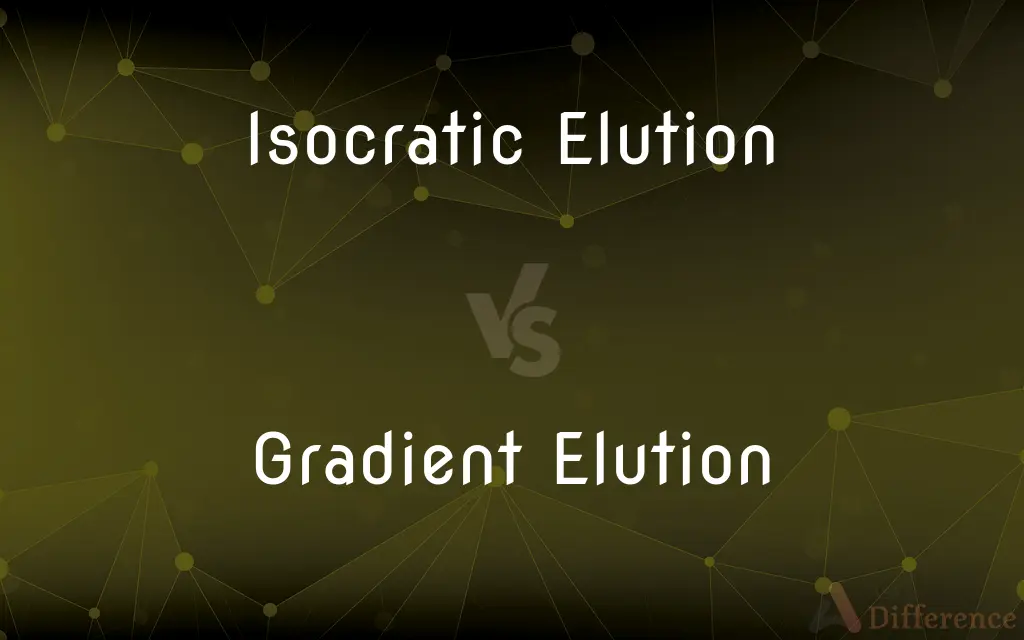Isocratic Elution vs. Gradient Elution — What's the Difference?
By Tayyaba Rehman — Published on January 31, 2024
Isocratic elution uses a constant solvent composition, while gradient elution varies the solvent composition over time for separation in chromatography.

Difference Between Isocratic Elution and Gradient Elution
Table of Contents
ADVERTISEMENT
Key Differences
Isocratic elution in chromatography involves the use of a constant mobile phase composition throughout the separation process. In contrast, gradient elution changes the ratio of solvents in the mobile phase over time, usually starting with a weaker solvent and gradually transitioning to a stronger one.
Isocratic elution is simpler and often used for separating compounds with similar properties. Gradient elution, however, is more versatile and effective for separating a wider range of compounds with varying polarities.
In isocratic elution, the retention times of analytes are consistent between runs, making it easier to predict and reproduce results. Gradient elution, with its changing solvent strength, can lead to varying retention times, requiring more precise control and monitoring.
Isocratic elution is often preferred for routine analysis where the sample composition is well-known and does not vary much. Gradient elution is more suited for complex mixtures or when exploring the separation conditions for unknown samples.
The choice between isocratic and gradient elution depends on factors like the complexity of the sample, the desired resolution, and the available time for analysis. Isocratic elution is more straightforward and cost-effective, while gradient elution offers greater flexibility and efficiency for complex separations.
ADVERTISEMENT
Comparison Chart
Solvent Composition
Constant throughout the process
Varies, usually from weak to strong solvent
Complexity of Mixtures
Suitable for simpler mixtures
Better for complex or unknown mixtures
Reproducibility
High, with consistent retention times
Can vary due to changing solvent strength
Suitability
Ideal for routine analysis
Preferred for exploratory or detailed analysis
Resolution
Good for similar compounds
Higher resolution for a wide range of compounds
Compare with Definitions
Isocratic Elution
In isocratic elution, the mobile phase composition remains unchanged, simplifying the process.
Isocratic elution was used to maintain consistency in the monthly testing of pharmaceutical samples.
Gradient Elution
Gradient elution offers higher resolution and flexibility in chromatographic analysis.
For comprehensive profiling of the plant metabolites, gradient elution was the preferred method.
Isocratic Elution
Isocratic elution uses a constant solvent composition throughout the chromatographic run.
In a routine analysis of caffeine, isocratic elution provided consistent and reliable results.
Gradient Elution
In gradient elution, the mobile phase gradually shifts from a weaker to a stronger solvent.
Gradient elution helped in separating closely related impurities in a chemical synthesis product.
Isocratic Elution
Isocratic elution is ideal for samples with known and similar chemical properties.
For the quality control of acetaminophen, isocratic elution was the chosen method.
Gradient Elution
Gradient elution involves changing the solvent composition during chromatography.
To analyze a complex herbal extract, the lab used gradient elution for better separation.
Isocratic Elution
Isocratic elution maintains a single solvent strength for separating compounds.
The laboratory used isocratic elution for the quick analysis of aspirin in a tablet.
Gradient Elution
Gradient elution is suited for samples with diverse or unknown chemical properties.
The research team employed gradient elution to analyze the complex environmental sample.
Isocratic Elution
Isocratic elution offers ease of use and reproducibility in chromatographic separation.
The isocratic elution method simplified the training process for new technicians.
Gradient Elution
Gradient elution adjusts solvent strength to separate a wider range of compounds.
Gradient elution was essential for resolving multiple components in the new drug formulation.
Common Curiosities
Why is gradient elution beneficial for complex samples?
Gradient elution can separate a wider range of compounds due to the changing solvent strength.
When is isocratic elution typically used?
Isocratic elution is used for simpler, routine analyses where the sample composition is known.
Is training for isocratic elution simpler than for gradient elution?
Generally, training for isocratic elution is simpler due to its straightforward methodology.
What are the cost implications of isocratic versus gradient elution?
Isocratic elution is generally more cost-effective due to its simplicity and use of fewer solvents.
What is isocratic elution?
Isocratic elution is a chromatographic technique using a constant solvent composition throughout the run.
How does gradient elution differ from isocratic elution?
Gradient elution varies the solvent composition during the run, unlike the constant solvent in isocratic elution.
Is isocratic elution easier to set up than gradient elution?
Yes, isocratic elution is generally simpler and easier to set up compared to gradient elution.
Can gradient elution achieve better separation than isocratic?
Yes, gradient elution often achieves better separation, especially for complex mixtures.
How does solvent choice impact isocratic elution?
In isocratic elution, the chosen solvent must adequately separate all components, as it remains constant.
Are retention times consistent in isocratic elution?
Yes, isocratic elution typically has consistent retention times for each analyte.
Does gradient elution require more advanced equipment?
Gradient elution usually requires more sophisticated systems capable of changing solvent compositions.
Can gradient elution handle a broader range of molecule types?
Yes, gradient elution is more adaptable to a variety of molecule types due to its changing solvent strength.
How does gradient elution improve resolution in chromatography?
Gradient elution improves resolution by optimizing solvent strength for different components during the run.
What kind of samples are best analyzed by isocratic elution?
Isocratic elution is best for analyzing samples with few components or known, similar chemical properties.
Are there any limitations to using gradient elution?
Gradient elution can be more time-consuming and requires careful optimization of solvent gradients.
Share Your Discovery

Previous Comparison
Jesuits vs. Roman Catholics
Next Comparison
Informed Search vs. Uninformed SearchAuthor Spotlight
Written by
Tayyaba RehmanTayyaba Rehman is a distinguished writer, currently serving as a primary contributor to askdifference.com. As a researcher in semantics and etymology, Tayyaba's passion for the complexity of languages and their distinctions has found a perfect home on the platform. Tayyaba delves into the intricacies of language, distinguishing between commonly confused words and phrases, thereby providing clarity for readers worldwide.












































